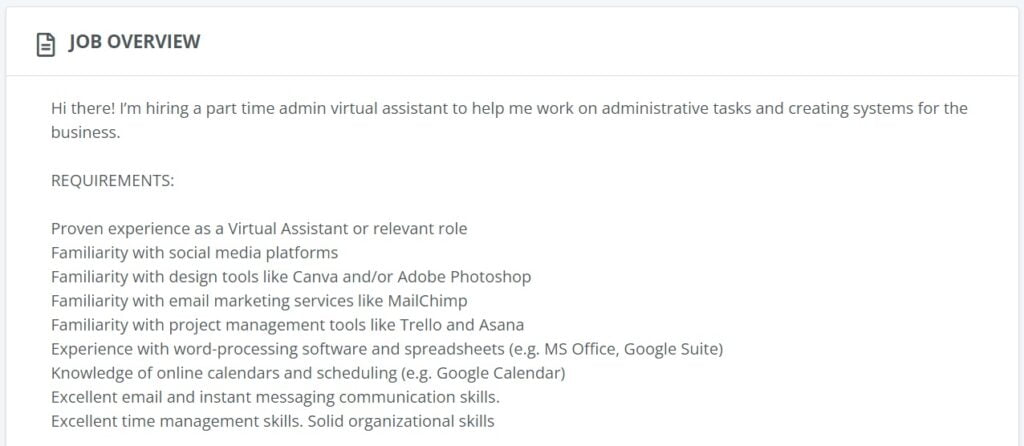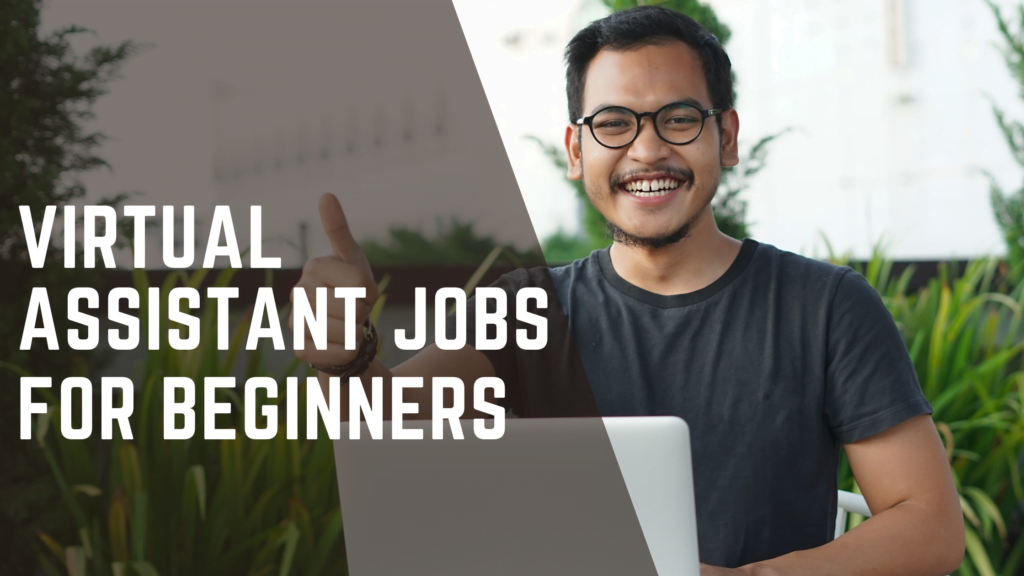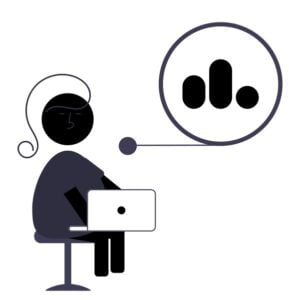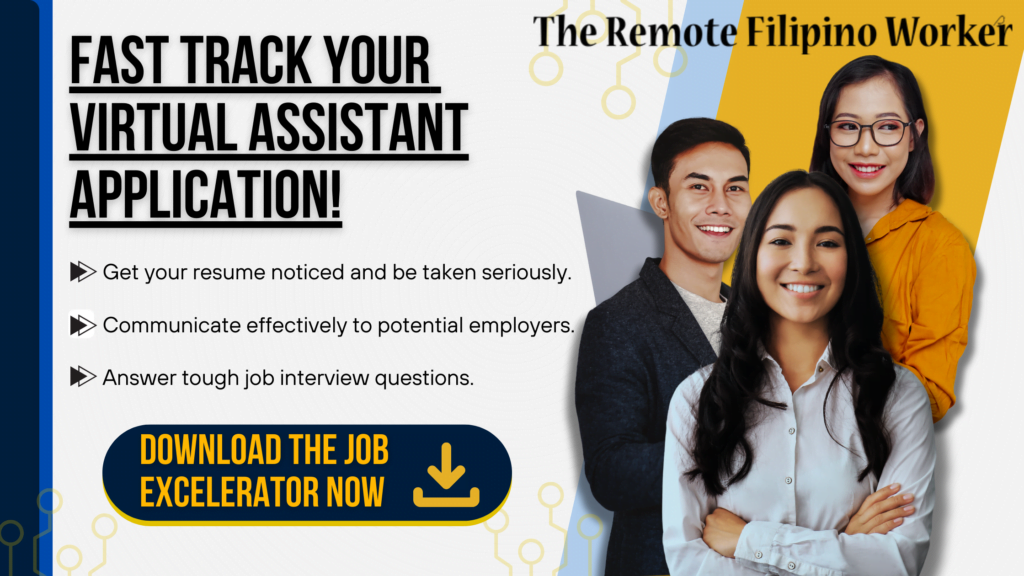You’ve seen it on social media, from TikTok to Facebook. People are sharing their lives and successes as virtual assistants, or VAs, for short. It’s even harder to resist the curiosity especially as influencers are hyping up the possibility of high earnings.
So, you finally decide that you want to try it out yourself. But then you realize that you have no idea where to start.
I’m here to tell you that the path to becoming a virtual assistant isn’t as easy as it seems to be. Especially with the amount of confusing; or even misleading information out there. So, in this guide, I’d like to share with you how I would start a successful virtual assistant career step by step.

Here are the steps on how to become a virtual assistant in the Philippines:
Step 1: Research Virtual Assistant Job Requirements
Step 2: Choose Between Going Direct-to-Client or Through an Agency
Step 3: Set a Target & Improve Virtual Assistant Skills
Step 4: Prepare Virtual Assistant Equipment
Step 5: Update Virtual Assistant Resume, Profile, or Portfolio
Step 6: Set up Payment Collection Methods
Step 7: Apply to VA Jobs & Prepare for Interviews
Step 8: After Getting Hired, Keep Investing in Yourself
But before we delve deeper into the how, let’s talk about the what. What exactly is a virtual assistant?
Table of Contents
What Is a Virtual Assistant?
Before all the hype, virtual assistants were simply remote workers who handled general administrative tasks for clients in a remote setup. However, the term has seen increased use even in more specialized professions, such as technical and creative niches.
Because of this, the definition of a virtual assistant or VA has expanded over the years. Nowadays, a virtual assistant can be defined as a professional who provides support services to clients through a remote or online setup. These support services can be administrative, specialized, or even a mix of the two.
There are social media VAs, graphic design VAs, bookkeeping VAs, and many others. Honestly, I am strongly against adding the virtual assistant term to everything because of two reasons.
First, adding VA to every profession has diluted and devalued the meaning of those specialties. This has led to some specialized professions to see a decrease in perceived value and a corresponding decrease in salary.
For you, this just means that even if the term VA is tacked on to your chosen profession, you should still demand pay befitting your skills and experience. For example, graphic design VAs are still graphic designers and should be compensated as such.
The second reason that I dislike having VA added to everything is that it leads to various misconceptions about online work and the virtual assistant field. You don’t always have to be a virtual assistant to earn a living online! There are many other paths available.
The 2 Main Types of Virtual Assistants
There are two main types of virtual assistants: 1) General Virtual Assistants and 2) Specialized Virtual Assistants. A general virtual assistant is a type of VA who is expected to handle a range of administrative work such as email management, scheduling, and data organization.
Meanwhile, specialized virtual assistants are a type of VA with the skillset necessary for industry-specific or skill-specific work. Examples include real estate virtual assistants and Amazon VAs.
This means that there are two paths open to you to become a VA. The general VA path is excellent for beginners and students without a defined skillet. You can just use your basic computer and organizational skills.
But if you already have experience, then a specialized VA path might be better for you. Not only would you have an advantage over beginners, but you also have the chance to be paid your worth.
Video Guide: Common Mistakes of Beginner Virtual Assistants
8 Steps: How to Become a Virtual Assistant in the Philippines
Now that you have a better idea of what a virtual assistant actually is, it should also be clear to you why it’s so confusing for many people to start their VA careers. Not only are there many different kinds of VAs, but there are also various paths to becoming one. That’s why the first step is unsurprisingly, getting more information.
Step 1. Research Virtual Assistant Job Requirements
Your goal in this step is to understand what value clients are looking for when they are hiring virtual assistants from the Philippines.
Go to online job platforms, such as Onlinejobs.ph and Upwork, and read various VA job descriptions from there. You can also look at the job requirements from the different virtual assistant agencies in the Philippines.
Let’s analyze this sample virtual assistant job from Onlinejobs.ph:

By just looking at the requirements, it seems this person is hiring a VA to help with at least three segments of their business. First is content creation for social media. The second is communicating with customers and people within the team. And lastly, organizing project timelines and team schedules.
Are these something that matches your skill set? Are they something you can learn?
Keep researching different VA jobs until you learn what skills and qualities clients are looking for. This will be different depending on the type of VA job. But it will also give you an idea of what kind of VA job matches you.
Step 2. Choose Between Going Direct-to-Client or Through an Agency
For aspiring VAs, there are two methods available for you to become a virtual assistant. First, is going direct to client. The second is by going through an agency. Each method has its own share of pros and cons. The approach you use to get hired will also be different.

a. Direct to Client
Finding a client on your own, through job sites or social networks, is called “direct to client.” Here are some things to consider when choosing this method:
- For this method, it’s up to you to impress the client using whatever method you see fit. You can be as creative as you want as long as you can showcase your value to the client.
- You are free to choose your clients and to set your own price. However, you might find getting clients difficult if you don’t have any client service, communication, and selling skills.
- You have to pay for your own work expenses as well as any government requirements. So, definitely don’t price too low.
- You have the freedom to take multiple clients at once as long as you are not bound by any contract. Balancing multiple tasks might be difficult, but you also have the option to run it as a business and hire people to work for you.
- You are on your own. You have no mentors to turn to unlike when in a company. But you can always join online job groups, like r/buhaydigital, to ask more experienced VAs.
- I also see this being difficult for beginners due to the high presence of online job scams. It’s also possible to get bad clients who do not pay you on time or abuse the job scope.

b. Through VA Agencies
The other method, going through virtual assistant agencies, is very popular with beginners since they’re the ones who match VAs with clients.
I’m sure you’ve probably heard about the Cyberbacker and Athena VA agencies. They are just two out of the hundreds of VA agencies out there.
Here are some noteworthy points about VA agencies in general:
- In this method, you have to follow the hiring process of the agency. Their HR people will be the ones to see your resume and portfolio. So, you have to customize your application to appeal to them.
- Passing the hiring and training process doesn’t automatically mean you can start working immediately. Finding you a client might still take time. And depending on the agency, you may not be paid while you wait.
- Your pay is limited to your agreement with the VA agency. But you can always go independent after gaining enough experience and confidence.
- If they have a registered business in the Philippines, they will also be responsible for paying your taxes and benefits. Also, some VA agencies provide equipment for their employees but this is a very rare exception.
- More often than not, full-time positions will be bound by a contract. You might be restricted in terms of the number of jobs that you can do at the same time.
Since you need to set a target to increase your chances of becoming a VA, the method you choose will affect what you need to prepare moving forward. While it’s true that you can use both methods at the same time, it can get overwhelming.
For now, just stick to one. If after a while, you think that the method you chose isn’t working, you can always change your approach.
Step 3. Set a Target & Improve Your VA Skills
The next thing you have to do is to choose a specific kind of VA job as your target. For that kind of VA job, what value are clients (or agencies) looking for? Is this something you can deliver?
Let’s look at the previous example again:

Most aspiring VAs will be familiar with email, spreadsheet, and instant messaging apps. But specialized software like Canva, Trello, Asana, and MailChimp might be unfamiliar to you.
If so, then you need to improve your VA skills to meet those job requirements. There are many videos available on YouTube where you can learn how to use them for free. Most of these programs also have a free version that you can tinker with right now.
You don’t have to wait to get hired to start. Practice and apply these software either to your daily needs or even to an imaginary client. Whatever you create can be part of your resume and portfolio later when you update them.
Lastly, there are also structured VA courses available online if you have the budget for them. But take note that what you learn there may not exactly be what your target client is looking for.
Everything you need to study might feel like a huge undertaking. It’s okay, you can take your time and start small. Even an hour each week is fine as long as you start now.
Step 4. Prepare Your VA Equipment
Aside from improving your skills, it is equally important to start preparing your equipment. While being a VA isn’t supposed to require any high-end equipment, having the right equipment will also help you practice your skills better.
The most important piece of equipment for a virtual assistant is a computer, either a desktop or laptop. If you plan to work directly with a client, there’s no need to worry much about your computer’s specs as long as you can provide the results they need.
However, if you plan to apply to virtual assistant agencies, then they have strict requirements for your computer and internet specs. Typically, the big VA agencies require at least an Intel Core i5 processor or the AMD equivalent, Ryzen 5 series. For internet speed, they want at least a wired internet connection, like DSL or Fiber, with at least 10 Mbps speed.
If you don’t have a computer on hand, you might want to check out our guide on recommended laptops for virtual assistants. The ones fit for VA work start from around ₱20,000-₱30,000.
Aside from that, there are other kinds of essential work-from-home equipment that you might need such as a noise-canceling headset.
The Mpow HC6 headset in particular can help you avoid any embarrassing noise during your job interview. One feature that lets it stand out above the rest is that it lets you hear how you (and your surroundings) sound to a listener.
If you’re on a budget, there are free software options, like Krisp.ai. You can use them on trial mode for a while until you earn enough for your headset.
You might also want to invest in an ergonomic chair, a laptop stand, and an ergonomic mouse eventually. Of course, you don’t have to buy them all right now. You can wait until you earn a comfortable amount, though, these accessories do improve the work experience by a lot.
Step 5. Update Your VA Resume, Profile, or Portfolio
Okay, so you’ve done your research, set a target, improved your skills, and prepared your equipment.
At this point, you know what would pique a client’s interest when you submit an application. It’s now time to update your resume, online profile, or portfolio based on what you’ve learned. But whatever you send, you need to stand out with just one glance.
Each platform has a different way of showcasing your qualifications to your client. For agencies, you need to create a customized VA resume and portfolio as per the requirements of the job.
I’ve applied to a lot of online jobs in the past decade and I can tell you from experience that customizing each application to highlight what’s relevant to the job has the highest success rate. Although that can be time-consuming and difficult if you don’t know what you’re doing.
That’s why we made the FREE online job application tool, the RFW Job Excelerator, to help out aspiring virtual assistants like you.
In this tool, you just need to fill up a questionnaire. Then, by using AI, it transforms what you’ve shared into best practices for job applications, from resumes to interview helpers.
For more details about the RFW Job Excelerator, see “Free ChatGPT Resume Template: How to Land a Job Using AI“.
Note that when you are using job platforms such as Onlinejobs.ph or Upwork, you usually need to create an online profile on that website. Each platform has its own form and layout that you need to follow in order to attract clients. For example, you can maximize your profile on Onlinejobs.ph by showcasing only the skills relevant to your application.
Step 6. Set up Your Payment Collection Methods
The next step is to prepare a way for your client (or agency) to send you your salary. If you plan on working with an agency, you can just prepare a bank account. But getting your payments from direct clients abroad requires a bit more preparation on your part.
There are many ways to do so. Popular methods include Wise, Payoneer, and PayPal. In case you want to know, I personally use both Wise and PayPal for different clients.
Each payment method has its own pros and cons that you need to consider properly.
For example, PayPal can be considered the most accessible for your potential clients. But from what I’ve experienced, it also has the highest conversion fees.
Wise and Payoneer are excellent alternatives since you can get a bank account number for countries like the USA, Australia, Canada, and the UK. This is the method I use for my Australian client. The client just sends the money to my Wise account through a local bank transfer.
You can also ask your client to create an account in Wise or Payoneer. From there, they can send your payment directly to your bank account. This is the method I see recommended the most in virtual assistant communities.
Note that a lot of these payment methods take some time to verify your account. So, while waiting you can move on to the next step.

Step 7. Apply to VA Jobs & Prepare for Interviews
Finally, after all that preparation, it’s time to actually apply for virtual assistant jobs.
As you’ve probably understood by now, a lot of the work you need to do to increase your success rate in landing a VA job happens before you even apply. But it will be all worth it. This method will help you stand out from other people applying to be a VA.
Administrative work is crucial for businesses. So, employers would love to be able to hire someone who can take on that responsibility even when unsupervised.
But employers also want someone they can communicate well with, especially in a remote work setting. So, they conduct interviews to get a feel for your personality, as well as, how they can work together with you.
That’s why it’s also important to practice doing interviews. You can do this on your own in front of a mirror, or you can even record yourself through your phone or webcam. This is especially important if you don’t use English regularly in your daily life.
Lastly, don’t forget that interviews go both ways. You should also ask your employer (or agency interviewer) crucial questions about the job. Here are some questions you can ask:
- What does a day of doing the job look like?
- How will the results of the work be evaluated?
- What will be the regular channel of communication?
- What tools or training will be needed to do the job well?
These questions not only show them your expertise, but also your genuine interest in getting hired.
Step 8. After Getting Hired, Keep Investing in Yourself
Congratulations on coming this far! Completing steps 1 to 7 will give you the best chance to become a virtual assistant in the Philippines. This last step is something you should remember when you finally get hired.
You see, just like most jobs, your first job as a virtual assistant isn’t permanent. You never know when a client may no longer need your services.
So, whether you are hired directly or through an agency, you should be prepared for that eventuality.
That’s why you should always keep investing in yourself. Perform well in your current job. Grow your network. Niche down and keep building your in-demand skills and work experience.
But most importantly, learn how to find clients on your own without the need for an agency or a job marketplace. If you are truly serious about doing remote work full-time, then this is the only way to ensure a long-term stable income through online jobs.

Debunking Common Misconceptions About Being a VA in the Philippines
I see a lot of misconceptions about being a virtual assistant when I lurk in online job communities. You should know that a lot of the word-of-mouth and social media hype about becoming a virtual assistant in the Philippines comes from the marketing machines of VA agencies or course sellers.
They are promoting the VA profession for their purposes. So, they are focused on showing only the positive sides of being a VA.
Below are some common misconceptions about being a VA in the Philippines:

a. Becoming a Virtual Assistant Is Easy
Despite what social media tells you, the path to becoming a VA isn’t easy, even more so becoming a successful one. I can’t even count how many stories of failure I’ve read and watched online. Where do people fail the most? Most troubles come from finding and keeping clients.
Generally, there are two ways to become a VA. First, aspiring VAs can work directly with clients as an independent contractor. This is the preferred method for people who are confident in their skills.
However, there’s a lot of competition in online job marketplaces. If you can’t sell yourself well to your client, then they might pass on your application. Closing clients is the most essential skill for an independent VA to have.
The next method, which is the most common way of becoming a virtual assistant in the Philippines, is by going through middlemen such as virtual assistant agencies. Excellent VA agencies not only train you but can also find the right clients for you. However, they also have stringent hiring processes. Plus, the potential for higher pay is smaller and agencies usually expect full-time commitment from you.
And this is just dipping your toes into the profession. After becoming a beginner VA, you need to upskill and build a network of clients to grow your income further.
In fact, you can even say that becoming a VA is just like running your own online business. You can’t be complacent otherwise you can get left behind.
b. Virtual Assistants Earn Big Money
Virtual assistants do have the potential to earn more compared to working locally, this is true. But the key word here is “potential.”
When you work as a VA under an agency, well, you don’t have much control over your pay. That’s why many VAs who start in agencies go independent after their contracts are over.
Independent VAs need to find their own clients. A VA can work with clients locally in the Philippines, but usually prefer working with clients from abroad due to the higher pay. But high-paying foreign clients aren’t easy to find either. That’s why it’s an essential skill that you need to learn once you go independent.
If you do eventually find a high-paying client, there’s always the chance that you lose them for whatever reason. Your monthly income will then take a big hit.
There’s also the option to work with multiple clients at once. But juggling the workload can be a difficult balancing act.
Also, independent VAs typically pay for their own work expenses as well. They use their own equipment, internet, and electricity. Plus, they need to pay Philippine government-mandated benefits and taxes themselves.
There are a lot more things to consider aside from these. That’s why it’s important to treat being a VA as something like a business. You need to prepare yourself for situations that can negatively affect you.
c. There’s More Freedom in Life as a VA
This is partially true. Since you are working from home, you don’t need to suffer through Philippine traffic. But a virtual assistant typically needs to report for their shift, usually at the same time as the client’s work hours. However, you can always schedule the other things you want to do around that commitment to your client.
There are also times when you can work unsupervised as long as you produce the required output. For those times, you can even run errands or take a break during your work day since you are the one in control of your time.
But of course, you will be the one responsible for your own productivity. You still need to do your job well if you don’t want to lose your clients.

Can I Become a Virtual Assistant with No Experience?
Yes, following the step-by-step method outlined in this guide will still work for aspiring virtual assistants with no experience yet. Becoming an administrative VA doesn’t have a strict skill set. So, it’s all about being able to show the skills and qualities that employers look for when hiring VAs.
How to become a virtual assistant in the Philippines with no experience? Like mentioned in the guide, start by researching what skills and qualities employers are looking for. Then, improve your resume, profile, and portfolio to match those requirements.
Certain qualities might be hard to show in written form. So, when applying to a job that needs those, a portfolio or a video resume might help. It’s important to do what you can to stand out from the competition especially if you find that your resume looks empty.
Is It Possible to Become a Part-Time VA as a Student?
Sure, I see a lot of students who work as virtual assistants on the side to fund their studies. The same steps for becoming a VA will apply. But as a student, you’ll have more limitations.
For example, most of the big VA agencies don’t accept part-timers. However, there are a few small to medium-sized agencies that you can try. Also, since you are balancing your studies and work, you have to be very careful about the schedule you take.
In general, it’s probably better for students to find direct clients instead. You can look for part-time VA work anywhere, from online job sites to social media, as long as you know how to market yourself.
Instead of VA jobs, output-based work where you’re more in control of your time might be better for you. You can try out jobs such as writing, content creation, video editing, etc. This way, it will be easier to balance your studies and your work.
How Much Does a Virtual Assistant Make in the Philippines?
According to salary aggregators like Glassdoor and Payscale, the average earnings for virtual assistants in the Philippines is around 2.50 to 3.50 USD per hour. This translates to around ₱22,000 to ₱31,000 a month.
It wasn’t this low during the early 2010’s. The salary that virtual assistants from the Philippines has certainly taken a hit over the years. This is due to increased competition, the popularity of AI, and Filipino VAs themselves agreeing to lower rates.
You can even find VA job postings that offer as low as 1 USD per hour – a dreadfully low rate! Even if you are a beginner, I recommend avoiding jobs that offer rates like these.
Why? First, jobs that offer rates like these also tend to come from employers who will work you like a dog. Second, is that it lowers the average VA rate for everyone else.
And then lastly, it’s because there’s such a thing as too low a rate that it won’t be able to even cover your expenses. Don’t forget that as a VA – you are your own business. This means you are paying for your internet, equipment, electricity, and even home office space.
At 1 USD per hour, you are earning less than ₱10,000 a month. That’s less than the minimum wage here in the Philippines. And definitely less than what you need for your living expenses in a month.
What Are Examples of Virtual Assistant Jobs for Beginners?

Usually working directly with the business owner, the general VA handles whatever administrative tasks that the client requires from them. This could be anything from doing research to organizing a meeting.
Search terms: virtual assistant, general virtual assistant, executive virtual assistant, executive assistant
2. Customer Service Virtual Assistant
As the name suggests, customer service VAs are tasked with responding to customer inquiries via email, phone, or chat. It’s not required but BPO experience is an advantage.
Search terms: customer service, BPO, chat support
3. Cold Calling Virtual Assistant
Cold callers are a type of customer-related work but your goal is to set appointments and make sales. If you excel in speaking English, then this is definitely a job you can do even as a beginner.
Search terms: cold calling, cold caller, appointment setter, telemarketer, sales chat support, follow-up specialist
4. Content Creation Virtual Assistant
This is one of the beginner VA jobs where the line between administrative and creative work is blurry. In this kind of work, you are in charge of making content for social media and websites. So, basic graphic design, writing, and video editing skills may be expected.
Search terms: social media VA, content VA, content scheduling manager
5. Data Entry Virtual Assistant
Data entry is a type of administrative (and repetitive) work. Your job is to compile information into a document or spreadsheet. There are also times when you will be required to do your own research before compiling the data.
Search terms: data entry, lead generation data entry, compliance officer
How Long Does It Take to Become a Virtual Assistant?
Just like with any job, there’s no sure timeframe that you can expect yourself to become a virtual assistant with certainty. So, if you are already working, don’t quit just yet. You don’t want to put yourself in a situation where you become desperate and would even take a low-paying VA job.
If you hang around Filipino online job groups such as r/buhaydigital, you’ll find people sharing stories of not being able to find a job for months (or even a year). Dealing with constant rejections can also be detrimental to your mental health.
If what you are doing isn’t working, then you might have to change your approach. So, while going through the process of trial and error, you can continue improving your skills and building your personal brand.
Are Virtual Assistant Courses Worth It?
The value of virtual assistant courses lies in providing (1) niche-specific knowledge, (2) a coherent learning structure, and (3) a reliable community. If you don’t get any of these from the course, then no that VA course isn’t worth it.
Are there any Philippine virtual assistant courses with value at all? In theory, you can learn everything about becoming a virtual assistant for free from YouTube, blogs, and other websites. But often, doing it on your own is slower due to a lot of trial and error.
In the end, it’s up to you to decide whether the benefits of a VA course outweigh the costs involved. So, do your research and ask for reviews on social media.
And lastly, once you do pay for a course, work and study hard to make the most out of it.

Is It Possible to Become a Virtual Assistant Without a Laptop?
It’s possible but it’s difficult and I can tell you that it’s not worth the trouble. Sure, there are some admin tasks that a general VA can do just through their phone. However, you don’t know when your employer might eventually ask you to work on something that can only be done through a computer.
You might get in trouble if you can’t complete it. It’s true that you could borrow a computer or work from a computer shop, but these methods are not something you can rely on every time a task like that comes in.
So, if you only have a phone to work with, I recommend setting your sights on a different profession. For example, mobile content video editing or email copywriting are jobs you can do even on a phone. See the article “Best Online Jobs Without a Laptop or Desktop (Just Mobile)” for more ideas.
Conclusion: Becoming a Virtual Assistant Is an Excellent Starting Point for Online Careers…
But as you should have learned by now, it’s not going to be a stable, high-paying career until you upskill and specialize. There’s a lot of competition for entry-level VA jobs and no job lasts forever. So, if you get stuck with beginner-level skills and lose your current job, then you might find yourself right back at the start.
So, don’t get complacent, and don’t get stuck in a VA agency. They are excellent starting points, but becoming independent is essential for a secure long-term career.
Niche down, improve your skills, sell yourself, and find better clients. Who knows? Maybe becoming a virtual assistant could be what eventually leads you to find your dream job.






